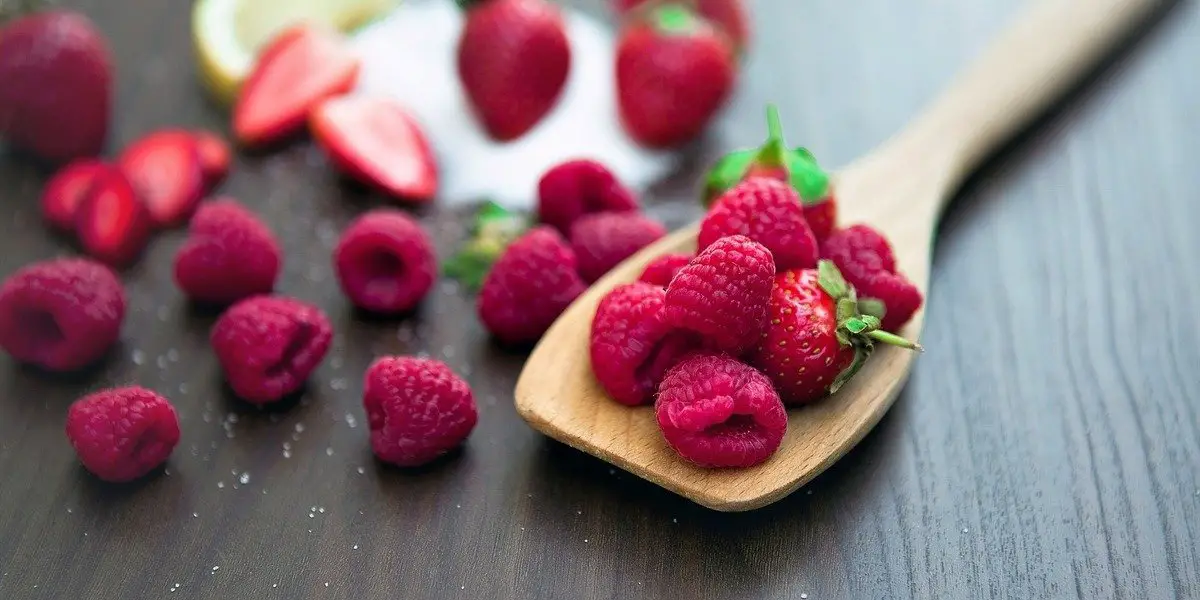Almost all foods are somewhat acidic, with a pH level below the neutral value of 7. It’s rare to find alkaline foods, especially in the fruit realm. For raspberries, the acidity is relatively high compared to some other fruits, comparable to the acidity of a strawberry.
On average, the acidity of raspberries can vary between a pH level of 3.2 and 4.0. This means that the raspberry is a very acidic fruit. Compared to other fruits, raspberries are about as acidic as an orange or strawberry, but less acidic than a lemon.
The pH level scale can go from acidic (pH of 0-7), to neutral (pH of 7), to alkaline (pH of 7-14). For reference: Battery acid would have a very acidic pH of <1, water has a neutral pH of 7, and bleach has a very alkaline pH of 12.5.
Raspberries Are Acidic Fruits
The relatively high acidity of the raspberry is quite interesting, especially because of the sweet flavor of the fruit. For people suffering from acid reflux (or even GERD), it is better to choose more pH-neutral fruits like bananas, apples, melons, or pears.
For the majority of people, tooth enamel decay might be the biggest worry. Regular consumption of any highly acidic food can affect the teeth long-term, without the proper care. Some people might know that orange juice can affect the teeth, but raspberry juice can do the same.
To prevent dental problems, we shouldn’t stop eating healthy fruits altogether. The risks of raspberries are minimal — soft fruits don’t need much chewing and it’s easy to mix with less acidic ingredients. The benefits clearly outweigh the health risks. Still, try to fight tooth erosion by:
- Neutralizing the acidity: Mix acidic fruits with less acidic options in a fruit mix or smoothie. Alternatively, flush your teeth with water immediately after consumption of acidic food or drink.
- Avoid tooth interaction: Use straws for acidic fruit juices where possible. Avoid having to chew raspberries and avoid keeping the fruit in your mouth for longer than necessary.
Preserving Raspberries & Acidity
Acidity is an important factor in preserving fruits for the long term. Some canning processes can only be chosen when the pH levels of the harvest are sufficiently low. This would make it harder for certain bacteria strains to develop in your preserved foods.
Botulism is a common risk in preserved fruits, caused by a microorganism called Clostridium botulinum. These bacteria can thrive in sealed canning jars, posing a potential risk. Preserved raspberries are too acidic for this microorganism to survive, since they are below a pH of 4.2. Canning raspberries with the water bath method is therefore likely safe.
Are Raspberries Sour?
Raspberries can both taste sour and sweet, depending on how ripe they were when they were packed. The relatively high acidity of the fruit has very little to do with its flavor, as most raspberries will generally taste sweet and tart.
Since raspberries are very acidic, one would assume that a raspberry will always taste sour. However, the flavor of the fruit has very little correlation with its acidity. That’s because there are plenty of sugars and fibers in the berries as well.
Raspberries do contain up to about 2.5% citric acid. Together with their relatively low sugar content, it’s clear to see why some of your berries might taste a little sour. The berries you’ll find in the store are extremely perishable, forcing producers to pick them unripe: that means the plant can’t provide all the sweetness a freshly picked fruit would.
Which Berries Are The Most Acidic?
A lot of popular berries are considered acidic. The most acidic berries include lemons (2.0-3.0 pH), limes (2.0-2.8 pH), cranberries (2.3-2.5 pH), grapes (2.9-3.8 pH), blueberries (3.1-3.3 pH), raspberries (3.2-4.0 pH), strawberries (3.0-3.5 pH), and blackberries (3.2-3.6 pH).
Your initial response might be that some of the fruits listed above aren’t berries. But they definitely are! Citrus fruits can be considered berries as well, as strange as it may seem.
Obviously, the list of popular berries and their pH levels described above is not exhaustive. There are many more fruit types that are technically classified as a berry. These usually have a much lower acidity level than one would usually expect based on their flavor pattern.
Soil Acidity Is Unrelated To Fruit Acidity
While this overview was not about gardening, it’s important to discuss soil acidity for a bit. For the raspberry plant (Rubus idaeus L.), it’s important to note that an acidic fruit does not mean the plant requires acidic soil.
In fact, crops with highly acidic fruit produce, including raspberries, require soil pH that is slightly only acidic or neutral. The only exception to the rule is the blueberry plant, which tolerates soil acidity levels as low as 4.5 pH. Learn more about the acidity of blueberries here.
If you’re living in the US in zones 3 to 10, the perennial shrub that produces raspberries can be safely grown from seed. It can survive the winter in most of these zones, providing you with a continuous supply of fresh berries. Feed it non-acidic soil and receive acidic berries in return, which are a lot less sour tasting than most supermarket raspberries!



